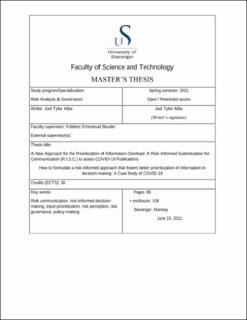| dc.description.abstract | The COVID-19 pandemic has shaken the foundations of every institution of the world. Current risk communication and decision-making paradigms have been confronted and challenged, and it has been made ever so insidiously clear, that a new era of decision-making and risk communication is upon us.
Hence, the establishment of the Fourth Era of Risk Communication, where decision-makers, experts, and the public alike, must acknowledge that the speed and magnitude with which data and publications are disseminated, overbears the current risk communication and governance frameworks employed. Therefore, this thesis attempts to convey that a risk governance paradigm emphasizing a newfound focus on the prioritization of risk-informed input, and public risk perception, provides the necessary wherewithal to address information saturation. As such, we posit the research question: How to formulate a risk-informed approach that fosters better prioritization of information in decision-making: A Case Study of COVID-19.
To accomplish this, a multi-tiered study was conducted to provide the data for the research. A six-month SRA study, published by the author, provided the bulk of the data, supplemented by six, Delphi-style-inspired interviews, providing the researcher the opportunity to delve deeper into the issues raised in the SRA study.
The purpose of the research is to provide decision-makers, stakeholders, experts, and the public, with a key understanding of how input selectivity affects the decision-making process, and ultimately, society as a whole. Hence, the proposal of the Risk-Informed Systemization for Communication (R.I.S.C.) framework.
The R.I.S.C. framework is yet but the budding of an idea, a spark to ignite the discussion; establishing a mediative-participatory regulatory style, intent on risk-informed input prioritization, is the first priority. Inducing a political culture that resides around the systemization of risk-informed input is a task that requires great political will, trust, time, and resources. The reinvigorated focus of risk-informed input prioritization must be the foundation with which the new era of risk communication frameworks operates. Ensuring the information entering the decision-making process follows the main tenets of R.I.D.M., provides the decision-makers with a streamlined, unified route of risk-informed information to better create a risk-informed, risk communication strategy. Accomplishing such a feat, provides a transparent, credible, and two-way, participatory governance paradigm, thereby establishing trust, credibility, and honesty, between the public, decision-makers, and experts. | |
